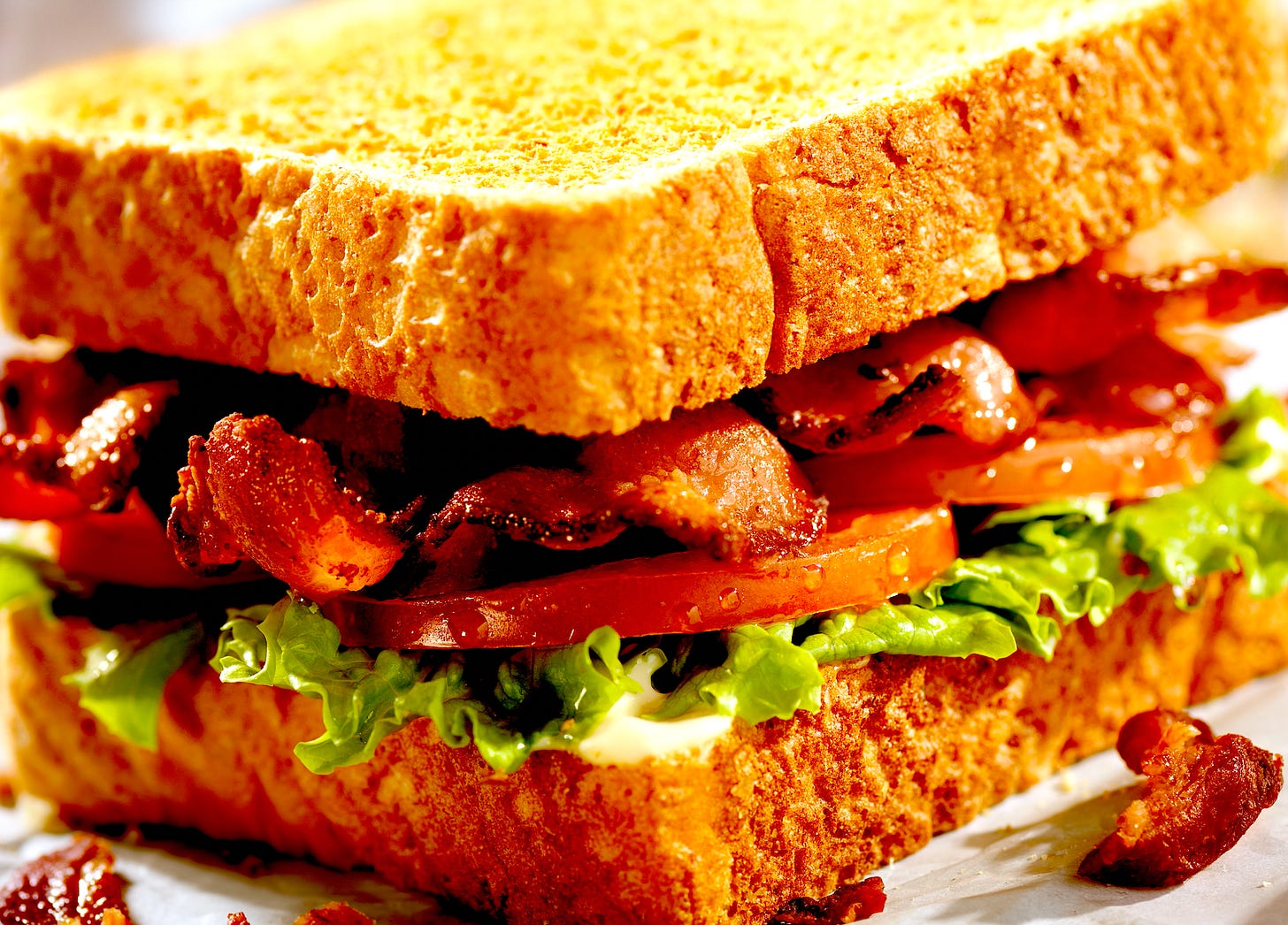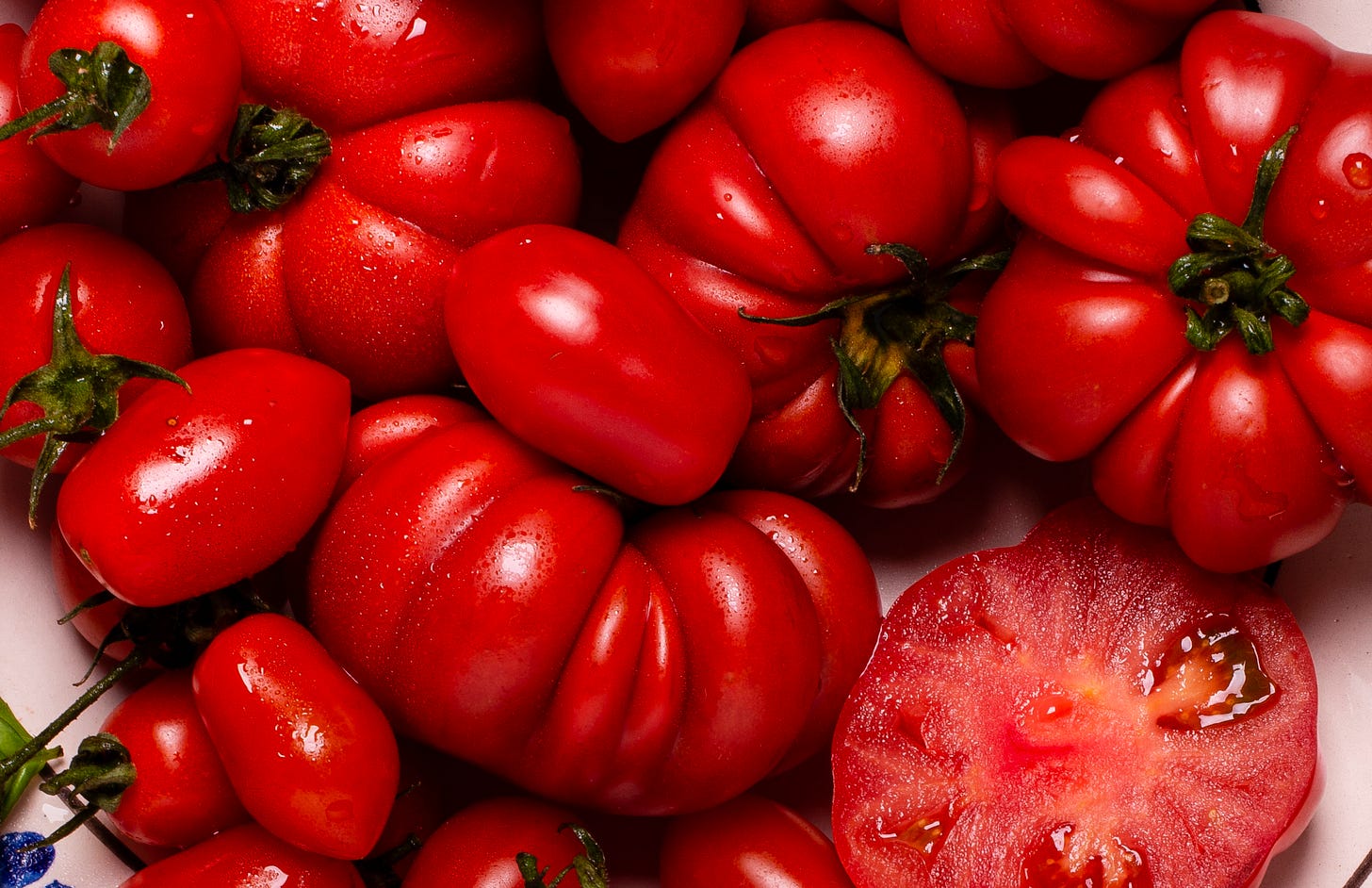Notable Sandwiches #13: The BLT
Deceptively simple, but also ubiquitous, and central, and deeply American
Welcome to the weekly feature where, every Friday, I take another bite from the nigh-inexhaustible and deeply weird resource that is Wikipedia’s List of Notable Sandwiches, in alphabetical order.
I’ve spent much of the past week being intimidated by a sandwich.
Ordinarily this would be a fairly preposterous predicament—a sandwich is inanimate, and in any case you can’t choke on the idea of a sandwich, which is really what I tend to write about—but tackling a topic with as mammoth a cultural footprint as the BLT is enough to make the most confident writer sweat like lettuce in the sun. The sandwich itself is deceptively simple—bacon, lettuce, tomato, like the acronym says—but also ubiquitous, and central, and so deeply American that I find myself quailing at the prospect of capturing it in a column.
Writing anything is the process of killing the perfect draft in your head, so the inevitably flawed one that forms on the page can hatch from its corpse like a wasp. In this case, the perfection I imagined was precisely the white-picket-fence, all-American sort I daily feel closed off from, with my Jewish childhood and my quasi-feral urban existence. America is a country so Christian that when you point it out, Christians will reassure you that the Christians who openly desire Christian theocracy aren’t “real Christians.” The BLT makes me feel the shadow of alienation and my own difference—like Christmas music, or Happy Meals—in ways that both please and unsettle me, and fill me with longing for a simpler life, and a stung, furious pride at who I am.
As has been covered here before, rather exhaustively as we steam through the list of “B” sandwiches, I grew up keeping kosher and therefore not eating bacon, which I did not taste until I was in my 20s. The best food writing is tied to sense-memory or great passion, and, thinking about the BLT, I realized I couldn’t remember if I’d ever eaten one—more damning even than a definitive “no.” Even if I’d gone out and snagged one at some eatery or another, or made one in my own kitchen, it would not replace years of fond childhood memory, or even the warm groove made by a beloved dish of adulthood.
The BLT is one of the few ubiquitous acronyms in American life not tied to a war or a brand—it’s not KFC or NATO or WWII or BMW or ICBM or AT&T, but all its own, no copyright, existing in every American city and even the smallest towns. The acronym is a vestige of the diner culture the sandwich emerged from in the ‘20s, a soda-jerk argot that’s largely vanished elsewhere. Wanting to do it justice, I turned outward and asked my Twitter followers what they remembered about BLTs from their own lives, and the responses were redolent with memory and recipe, a ripe vine of borrowed pasts to pluck from.
Here are a few of the BLT memories volunteered to me:
“It's not much of a story, but one of my earliest memories of cooking with my mother is making BLT sandwiches together in a tiny townhouse kitchen. She would fry up the bacon and I would use the entire time to slice a single tomato, going very slowly to not crush it or cut myself.”
“My grandmother used to take me to lunch at the local golf shop. BLT on toast and a cold coke. Toasted white bread, perfect tomato, crispy bacon that crumbles when you bite into it, fresh iceberg lettuce.”
“When my grandmother was toward the end of her life, she almost exclusively ate BLTs for lunch. So they make me think of her. Now when tomatoes are in season at the farmers market, my husband and I try to make the best BLT ever.”
“Summers at a 70s-era beach house (on stilts) in NC, a bunch of kids dragging our salt-caked butts back from the sand at midday, hosing off downstairs and coming to the kitchen for a massive stack of BLTs, made with a proper amount of mayo because ‘no dry sandwiches on vacation.’”
“My mom made the best BLTs with tomatoes from my grandpa’s garden.”
“My favorite BLT was from the Millington train station which was an actual train station but also a place where you could get a sandwich, which is when i realized you could also fall in love, with a sandwich—I was 7.”
“I'm a gardener and a sandwich fan, and my yearly ritual is making BLT's out of the first big tomato of the season. When I see that first beefsteak or brandywine turning red, it's BLT time. It's a sensory experience, a rich strata of textures and flavors to bite through. Top-tier.”
“At 18 I walked across Paris to Harry’s New York Bar to have a BLT but I got thrown out because I showed up in shorts. I cursed all the way back to the hotel, changed, returned, and was warmly welcomed and served the best BLT I ever had before or since.”
“My Momma loved them, God rest her. I remember eating them with turkey bacon, tomatoes from the garden, and Duke's mayo. When Dad was away at sea in the summer, we'd eat nothing but a pile of them for dinner. Perfect ‘no-AC-in-the-South’ food … Dad's allergic to raw tomatoes, so it really was a thing Momma and I ate when we were on our own. It made being on our own out in bumfuck feel like thriving, somehow.”
This was it: the kind of warm, soft-lit memory of grandmothers and mothers, bread and tomatoes, that makes a food essay purr with contentment. There were several restaurants fondly name-checked—Mel’s Cafe in Charlottesville, Virginia; the late Carnegie Deli, of New York; Crown Candy Kitchen in St. Louis; Tony’s, of Birch Run, Michigan, “Home of Tony’s Original One Pound BLT.” Still, even in these tender confines, there were rifts and dissent: mayo or no mayo, and what kind—Duke’s, Hellman’s/Best Food, vegenaise, Kewpie, homemade, Miracle Whip—and how much? Is it a seasonal sandwich, dependent primarily on the quality of the tomato, or a year-round treat, made just as well with the indifferent, mealy and pallid tomatoes of winter? Do you toast the bread? And what of the variants: the BLAT (adding avocado), the LGBTQ (queso and guacamole), or adding an egg, or parmesan, peanut butter or pimiento cheese, or savory jam?
The Sword and the Sandwich is a newsletter about serious extremism and equally serious sandwiches. Please consider supporting this work with a paid subscription:
To resolve these quandaries, I turned to J. Kenji López-Alt, cookbook author, New York Times columnist, and, most importantly for our purposes, the author of “The Food Lab BLT Manifesto,” a thundering argument for the primacy of the tomato in the BLT, a paean to seasonality, and to simplicity.
“A better name for the BLT might well be the Tomato Club,” López-Alt writes, “for it is the perfect tomato, not the bacon, that is the rarest, the most ephemeral, the most singularly delicious ingredient. A BLT is not a democracy. It is not a committee meeting. It is a dictatorship, and the tomato is King, Queen, and Supreme Leader. In the BLT universe, the Prime Directive is that all other ingredients shall be at Her Majesty's service, their only role to prop her up and enhance her best qualities.”
López-Alt lays out his vision with the precision and panache of any Starfleet captain: The tomato should be in season, it should be rich and juicy and vine-ripened, not plucked green and ethylene-gassed into redness. It should be salted and peppered to release its flavorsome potency. It should be layered with flat-baked bacon, not too much and not too high-end. The shredded iceberg lettuce secures the contents, braced against modest and non-distracting bread, which should be slathered generously with mayonnaise of your own preference. Eat it only when tomatoes are in season.
I approached the author of this rigid diktat with some trepidation, but found López-Alt surprisingly laid-back about the tenets of the BLT. He mentioned David Chang, outspoken evangelist for using humble, off-season, hothouse tomatoes; revealed that when he lived in California, he had subbed in avocado as “nature’s mayonnaise”; and avowed that, hey, it may not add much for him personally, but if you want to slap an egg on it, or throw in something pickled, c’est la vie.
The reason for this decidedly non-doctrinaire stance, López-Alt explained, was that he himself had grown up without any particular attachment to the BLT—his first encounter was in the unlovely confines of a college cafeteria, where the tomatoes were wretched. Not until the age of twenty did he have a truly good tomato, at which point the revelation—the point of all those tomatoes in all those sandwiches—dawned on his mind and tongue. “Not having a taste-nostalgia for a specific type of BLT, who am I to say that what someone remembers growing up is the wrong thing to have enjoyed?” López-Alt told me. “I grew up eating ‘Oodles of Noodles’ cup noodles, and I love good ramen and I love crappy ramen. It’s fine to enjoy both.”
A summer tomato is a joy of life, and, not being cut from the flesh of a hog, is a profound taste-memory for me: a tang of sunlight and acid in the mouth, sprinkled with salt, or eaten whole in the palm like an apple. I grew up in New Jersey, where the best American tomatoes come from, and I loved them so much as a kid that when squirrels broke into our kitchen and nibbled at the ripe ones in the basket (my own grandmother had a strict prohibition against storing tomatoes in the fridge), my family accused me of perverse tomato vandalism. I was innocent, vindicated by pointing out the tiny pinholes did not match my teeth, like a child forensic scientist. The point is: I can get down with a tomato sandwich with salty bacon for seasoning and lettuce for crunch, shored up by bread for heft and starch. This sounds like a piece of deliciousness to me, particularly as I sit in New York in January, waiting for a snowstorm to arrive, and yearning for summer to come.
I share with López-Alt the desire for something simple and very good, the taste of a warm day—crispness and salt, umami, fat, ribby greens. My longing is not proprietary—if you want to adorn yours with a poached egg or onion jam or arugula or airy piles of the finest brioche, go ahead—but more like a kind of toska, unsatisfiable yearning: for summer in winter, for a childhood where I fit in to this country without having to sand the edges down, where I wouldn’t have to worry if they let Jews into the golf club you went to with Grandma. I can’t ever have that—I wouldn’t even want to, really—but when June gives way to July and August, and the red riot of steaky broad globes make the vines hang low, I can take a bite of that feeling, and hold it on my tongue, salty, and vivid, and mine.








I savor your writing as one might the delicious summer tomatoes you so perfectly describe.
Only you can make an essay about a subject as pedestrian as a sandwich sing with history, culture and nostalgia.
You make me want to read and write more, and take me out of my anxious and worried mind for however long it takes me to race through your latest piece.
Thank you, and please, keep whatever pieces you might grace us with, coming.